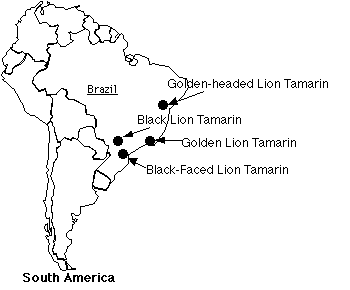|
|
BLACK LION TAMARIN
Leontopithecus chrysopygus
Locally known as the: sauimpreto, mico-leão-preto, and golden-rumped lion tamarin

|
|

Physical Appearance: As the name suggests, these tamarins are black with golden rumps.

Geographic Range: Black lion tamarins live in small, fragmented parts of the rainforest in the state of São Paulo
Biome: Tropical deciduous forest
Habitat: Rainforest of Eastern Brazil
IUCN Status: Endangered
Threats to survival: The clash between urban expansion and pristine rainforest in Sao Paulo causes black lion tamarins to be one of the most endangered species in the world. Roads are very important part of development by connecting rural people and goods to urban jobs and markets. However, these roads divide black lion tamarin habitats and vehicles traveling on these roads sometimes hit tamarins attempting to cross the road. Forests that were once very big and contiguous (without divide) are now in small patches, so the animals from one patch cannot meet other black lion tamarins. Lion tamarins are scared to walk on the ground because they can be eaten by a nake, a cat or hit by a car.
Dr. Claudio Pauda and other scientists used their creativity to find solutions. One idea was to build a bridge above the road, so tamarins can meet other tamarins and not be worried about crossing the road. Scientists are moving animals among different forest patches so they can meet and marry tamarins from different families. Researchers were very worried that they could have problems because of brothers marrying sisters or cousins.
|
In Captivity:
Jersey Wildlife Preservation Trust: In August 2001, the Jersey Zoo had 20 individuals comprising several groups. One group of 5 were free-ranging the woods, another group of 5 were in one of the tamarin enclosures, and the rest are non- breeding pairs or evicted single animals waiting to be placed. In 1999 a group that had been free-ranging here at Jersey was sent to Brazil for re-introduction. The reintroduction began well, but one of the males was unfortunately killed by an ocelot after 3 months. Extremely cold weather prevented some of the fruit trees, on which wild BLTs feed, from fruiting. This forced the tamarins to forage on the ground where they are at greater risk to predation. Now the zoo has begun "predator training" to increase the chances of success for re-introduced animals. Dominic Wormell (Deputy Head Mammals, JWPT) Central Park Wildlife Center: The first black lion tamarins in North America... The summer of 1995, four black lion tamarins arrived at the Central Park Wildlife Center (CPWC) in New York, NY. Photo's from the CPWC tamarin exhibit by Michael and Victoria Wilkinson.
|
Learn more about tamarins...
What do black lion tamarins sound like?
|
©2000
The Wild Ones
c/o Wildlife Trust
61 Route 9W, Palisades, NY 10964-8000
Tel: 845.365.8337 Fax: 845.365.8177